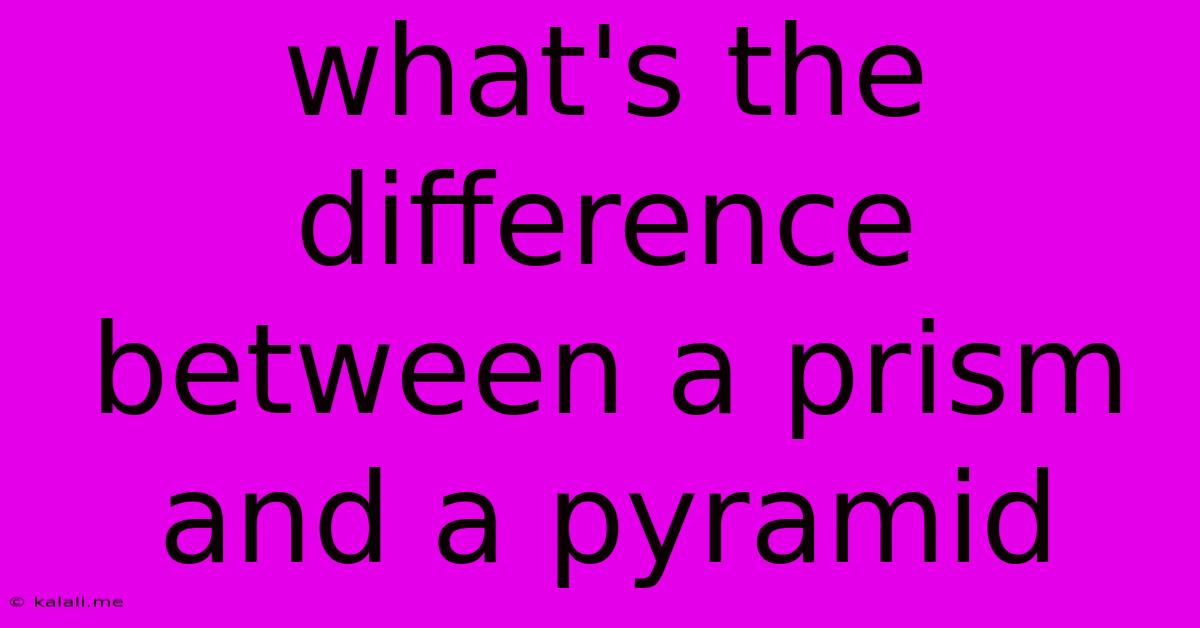What's The Difference Between A Prism And A Pyramid
Kalali
Jun 12, 2025 · 2 min read

Table of Contents
Prisms vs. Pyramids: Unraveling the Geometric Differences
This article will delve into the fascinating world of geometry, specifically exploring the key distinctions between prisms and pyramids. While both are three-dimensional shapes with flat surfaces, understanding their fundamental differences is crucial for anyone studying geometry or simply curious about shapes. This guide will clarify their unique characteristics, helping you easily differentiate between these geometric figures.
Prisms and pyramids are both polyhedrons, meaning they are three-dimensional shapes with flat polygonal faces. However, their construction and resulting properties differ significantly. Let's break down their defining features.
Defining a Prism
A prism is a three-dimensional shape with two parallel and congruent polygonal bases. These bases are connected by lateral faces, which are parallelograms. Imagine stacking two identical polygons on top of each other; the resulting shape, with connecting parallelogram sides, is a prism.
Key Characteristics of Prisms:
- Two congruent bases: These bases are identical polygons, situated parallel to each other.
- Lateral faces are parallelograms: The sides connecting the bases are parallelograms.
- Number of faces: A prism has a total number of faces equal to the number of sides in its base, plus two (for the bases).
- Examples: Cubes (a special type of rectangular prism), rectangular prisms, triangular prisms, hexagonal prisms, etc.
Defining a Pyramid
A pyramid, unlike a prism, has only one polygonal base. From this base, triangular faces converge at a single point called the apex or vertex. Think of it as a collection of triangles meeting at a central peak.
Key Characteristics of Pyramids:
- One polygonal base: This is the foundation of the pyramid; all other faces connect to this base.
- Triangular lateral faces: All the sides are triangles that meet at the apex.
- Number of faces: A pyramid has a total number of faces equal to the number of sides in its base, plus one (for the apex).
- Examples: Square pyramids (like the Egyptian pyramids), triangular pyramids (tetrahedrons), pentagonal pyramids, etc.
A Table Summarizing the Key Differences:
| Feature | Prism | Pyramid |
|---|---|---|
| Number of Bases | Two congruent and parallel bases | One base |
| Lateral Faces | Parallelograms | Triangles |
| Apex/Vertex | No apex | One apex |
| Shape of Sides | Parallelograms | Triangles |
Real-World Applications and Examples:
Understanding the differences between prisms and pyramids extends beyond abstract geometry. Many objects in our everyday lives exhibit these shapes. For example:
- Prisms: Boxes, building blocks, some crystals, and even honeycombs exhibit prismatic structures.
- Pyramids: The iconic Egyptian pyramids, certain types of tents, and some architectural designs are prime examples of pyramidal structures.
By understanding the defining characteristics of prisms and pyramids—the number of bases, the shape of their lateral faces, and the presence or absence of an apex—you can easily differentiate between these important geometric shapes. This knowledge provides a solid foundation for further exploration into more complex geometric concepts.
Latest Posts
Latest Posts
-
Distance Of A Penalty Kick Soccer
Jun 13, 2025
-
Earth Is Divided Into How Many Time Zones
Jun 13, 2025
-
What Are The First 5 Multiples Of 9
Jun 13, 2025
-
Singly Linked List Vs Doubly Linked List
Jun 13, 2025
-
Queen Mary University London Acceptance Rate
Jun 13, 2025
Related Post
Thank you for visiting our website which covers about What's The Difference Between A Prism And A Pyramid . We hope the information provided has been useful to you. Feel free to contact us if you have any questions or need further assistance. See you next time and don't miss to bookmark.